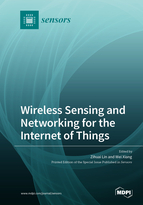Wireless Sensing and Networking for the Internet of Things
A special issue of Sensors (ISSN 1424-8220). This special issue belongs to the section "Internet of Things".
Deadline for manuscript submissions: closed (20 August 2022) | Viewed by 85191
Special Issue Editors
Interests: Internet of Things (IoT); wireless sensor networks; wireless communications; communication theory; information theory
Special Issues, Collections and Topics in MDPI journals
Interests: AI and Internet of Things
Special Issues, Collections and Topics in MDPI journals
Special Issue Information
Dear Colleagues,
In recent years, we have been witnessing the exponential proliferation of the Internet of Things (IoT) - networks of physical devices, vehicles, appliances and other items embedded with electronics, software, sensors, actuators, and connectivity that enables these objects to connect and exchange data. Enabling the introduction of highly efficient IoT, wireless sensing and network technologies will reduce the need for traditional processes that must currently be done manually, thus freeing up the precious resource of a dwindling working staff, to do more meaningful and necessarily human-centered work.
This Special Issue aims to bring together innovative developments in areas related to IoT, wireless sensing, and networking, including but not limited to:
- Wireless sensing for IoT;
- Joint sensing and wireless communications;
- MAC and network layer protocols for wireless sensor networks;
- Cross-layer design approaches for wireless sensor networks;
- Optimization for energy efficiency for wireless sensor networks;
- Optimization in localization and tracking, AI-based indoor positioning;
- Wireless artificial intelligence (AI) for IoT;
- Industrial IoT (Smart grid, Healthcare IoT, Intelligent Transportation Systems, etc.);
- Wireless energy transfer & ambient backscatter communications;
- Short code design for wireless sensor networks;
- Distributed source channel network coding for wireless sensor networks.
The sequel Special Issue "Wireless Sensing and Networking for the Internet of Things II" has been announced. We look forward to receiving your submission for the new Special Issue.
https://www.mdpi.com/journal/sensors/special_issues/84566SWJXO
Deadline for manuscript submissions: 20 April 2023.
Prof. Dr. Zihuai Lin
Prof. Dr. Wei Xiang
Guest Editor
Manuscript Submission Information
Manuscripts should be submitted online at www.mdpi.com by registering and logging in to this website. Once you are registered, click here to go to the submission form. Manuscripts can be submitted until the deadline. All submissions that pass pre-check are peer-reviewed. Accepted papers will be published continuously in the journal (as soon as accepted) and will be listed together on the special issue website. Research articles, review articles as well as short communications are invited. For planned papers, a title and short abstract (about 100 words) can be sent to the Editorial Office for announcement on this website.
Submitted manuscripts should not have been published previously, nor be under consideration for publication elsewhere (except conference proceedings papers). All manuscripts are thoroughly refereed through a single-blind peer-review process. A guide for authors and other relevant information for submission of manuscripts is available on the Instructions for Authors page. Sensors is an international peer-reviewed open access semimonthly journal published by MDPI.
Please visit the Instructions for Authors page before submitting a manuscript. The Article Processing Charge (APC) for publication in this open access journal is 2600 CHF (Swiss Francs). Submitted papers should be well formatted and use good English. Authors may use MDPI's English editing service prior to publication or during author revisions.








